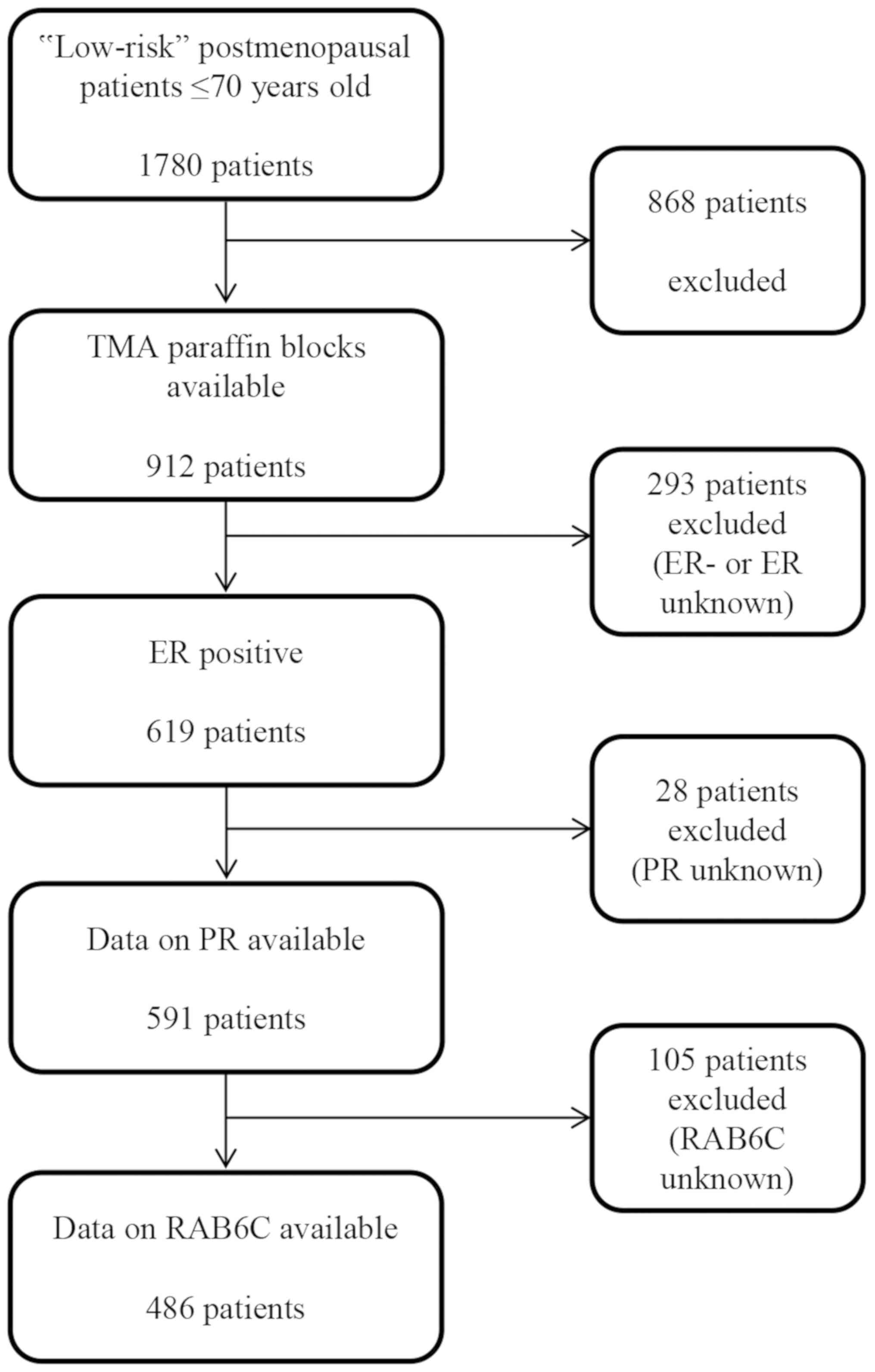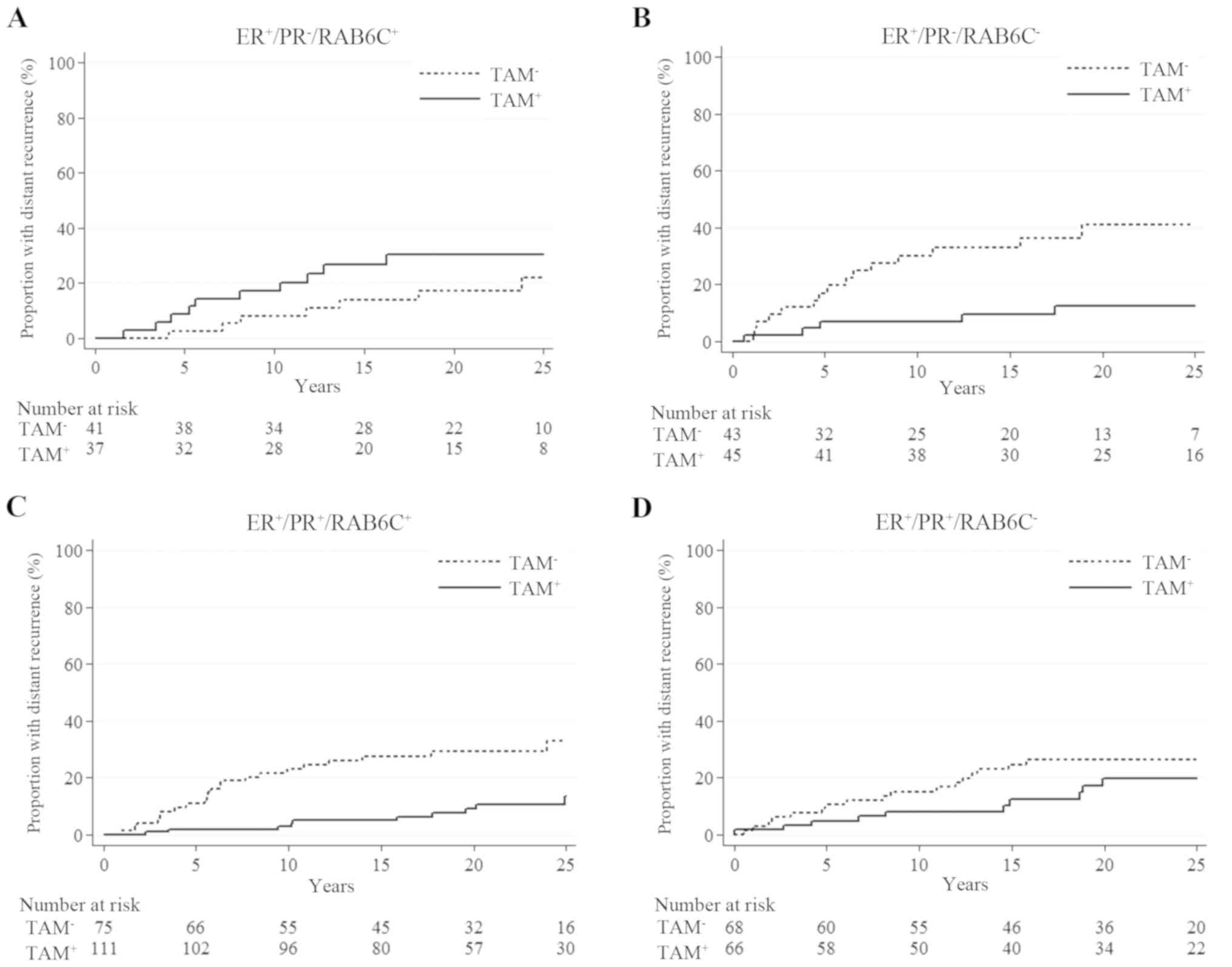|
1
|
Sant M, Chirlaque Lopez MD, Agresti R,
Sánchez Pérez MJ, Holleczek B, Bielska-Lasota M, Dimitrova N, Innos
K, Katalinic A, Langseth H, et al: Survival of women with cancers
of breast and genital organs in Europe 1999-2007: Results of the
EUROCARE-5 study. Eur J Cancer. 51:2191–2205. 2015.PubMed/NCBI View Article : Google Scholar
|
|
2
|
Fredholm H, Magnusson K, Lindström LS,
Garmo H, Fält SE, Lindman H, Bergh J, Holmberg L, Pontén F, Frisell
J and Fredriksson I: Long-term outcome in young women with breast
cancer: A population-based study. Breast Cancer Res Treat.
160:131–143. 2016.PubMed/NCBI View Article : Google Scholar
|
|
3
|
Nordenskjöld A, Fohlin H, Fornander T,
Löfdahl B, Skoog L and Stål O: Progesterone receptor positivity is
a predictor of long-term benefit from adjuvant tamoxifen treatment
of estrogen receptor positive breast cancer. Breast Cancer Res
Treat. 160:313–322. 2016.PubMed/NCBI View Article : Google Scholar
|
|
4
|
Gan L, Zuo G, Wang T, Min J, Wang Y, Wang
Y and Lv G: Expression of WTH3 in breast cancer tissue and the
effects on the biological behavior of breast cancer cells. Exp Ther
Med. 10:154–158. 2015.PubMed/NCBI View Article : Google Scholar
|
|
5
|
Cancer Genome Atlas Network: Comprehensive
molecular portraits of human breast tumours. Nature 490: 61-70,
2012.
|
|
6
|
Haverty PM, Fridlyand J, Li L, Getz G,
Beroukhim R, Lohr S, Wu TD, Cavet G, Zhang Z and Chant J:
High-resolution genomic and expression analyses of copy number
alterations in breast tumors. Genes Chromosomes Cancer. 47:530–542.
2008.PubMed/NCBI View Article : Google Scholar
|
|
7
|
Tian K, Wang Y and Xu H: WTH3 is a direct
target of the p53 protein. Br J Cancer. 96:1579–1586.
2007.PubMed/NCBI View Article : Google Scholar
|
|
8
|
Rutqvist LE and Johansson H: Stockholm
Breast Cancer Study Group: Long-term follow-up of the randomized
Stockholm trial on adjuvant tamoxifen among postmenopausal patients
with early stage breast cancer. Acta Oncol. 46:133–145.
2007.PubMed/NCBI View Article : Google Scholar
|
|
9
|
Khoshnoud MR, Löfdahl B, Fohlin H,
Fornander T, Stål O, Skoog L, Bergh J and Nordenskjöld B:
Immunohistochemistry compared to cytosol assays for determination
of estrogen receptor and prediction of the long-term effect of
adjuvant tamoxifen. Breast Cancer Res Treat. 126:421–430.
2011.PubMed/NCBI View Article : Google Scholar
|
|
10
|
Jerevall PL, Jansson A, Fornander T, Skoog
L, Nordenskjöld B and Stål O: Predictive relevance of HOXB13
protein expression for tamoxifen benefit in breast cancer. Breast
Cancer Res. 12(R53)2010.PubMed/NCBI View
Article : Google Scholar
|
|
11
|
Thakkar JP and Mehta DG: A review of an
unfavorable subset of breast cancer: Estrogen receptor positive
progesterone receptor negative. Oncologist. 16:276–285.
2011.PubMed/NCBI View Article : Google Scholar
|
|
12
|
Dowsett M, Houghton J, Iden C, Salter J,
Farndon J, A'Hern R, Sainsbury R and Baum M: Benefit from adjuvant
tamoxifen therapy in primary breast cancer patients according
oestrogen receptor, progesterone receptor, EGF receptor and HER2
status. Ann Oncol. 17:818–826. 2006.PubMed/NCBI View Article : Google Scholar
|
|
13
|
Bartlett JM, Brookes CL, Robson T, van de
Velde CJ, Billingham LJ, Campbell FM, Grant M, Hasenburg A, Hille
ET, Kay C, et al: Estrogen receptor and progesterone receptor as
predictive biomarkers of response to endocrine therapy: A
prospectively powered pathology study in the Tamoxifen and
Exemestane adjuvant multinational trial. J Clin Oncol.
29:1531–1538. 2011.PubMed/NCBI View Article : Google Scholar
|
|
14
|
Early Breast Cancer Trialists'
Collaborative Group (EBCTCG), Davies C, Godwin J, Gray R, Clarke M,
Cutter D, Darby S, McGale P, Pan HC, Taylor C, et al:
Relevance of breast cancer hormone receptors and other factors to
the efficacy of adjuvant tamoxifen: Patient-level meta-analysis of
randomised trials. Lancet 378: 771-784, 2011.
|
|
15
|
Bardou VJ, Arpino G, Elledge RM, Osborne
CK and Clark GM: Progesterone receptor status significantly
improves outcome prediction over estrogen receptor status alone for
adjuvant endocrine therapy in two large breast cancer databases. J
Clin Oncol. 21:1973–1979. 2003.PubMed/NCBI View Article : Google Scholar
|
|
16
|
Viale G, Regan MM, Maiorano E,
Mastropasqua MG, Dell'Orto P, Rasmussen BB, Raffoul J, Neven P,
Orosz Z, Braye S, et al: Prognostic and predictive value of
centrally reviewed expression of estrogen and progesterone
receptors in a randomized trial comparing letrozole and tamoxifen
adjuvant therapy for postmenopausal early breast cancer: BIG 1-98.
J Clin Oncol. 25:3846–3852. 2007.PubMed/NCBI View Article : Google Scholar
|
|
17
|
Bostner J, Skoog L, Fornander T,
Nordenskjöld B and Stål O: Estrogen receptor-alpha phosphorylation
at serine 305, nuclear p21-activated kinase 1 expression, and
response to tamoxifen in postmenopausal breast cancer. Clin Cancer
Res. 16:1624–1633. 2010.PubMed/NCBI View Article : Google Scholar
|
|
18
|
Young J, Ménétrey J and Goud B: RAB6C is a
retrogene that encodes a centrosomal protein involved in cell cycle
progression. J Mol Biol. 397:69–88. 2010.PubMed/NCBI View Article : Google Scholar
|
|
19
|
Uhlén M, Fagerberg L, Hallström BM,
Lindskog C, Oksvold P, Mardinoglu A, Sivertsson Å, Kampf C,
Sjöstedt E, Asplund A, et al: Proteomics. Tissue-based map of the
human proteome. Science. 347(1260419)2015.PubMed/NCBI View Article : Google Scholar
|
|
20
|
Bhat S, Kabekkodu SP, Varghese VK,
Chakrabarty S, Mallya SP, Rotti H, Pandey D, Kushtagi P and
Satyamoorthy K: Aberrant gene-specific DNA methylation signature
analysis in cervical cancer. Tumour Biol.
39(1010428317694573)2017.PubMed/NCBI View Article : Google Scholar
|
|
21
|
Bhat S, Kabekkodu SP, Jayaprakash C,
Radhakrishnan R, Ray S and Satyamoorthy K: Gene promoter-associated
CpG island hypermethylation in squamous cell carcinoma of the
tongue. Virchows Arch. 470:445–454. 2017.PubMed/NCBI View Article : Google Scholar
|
|
22
|
Salavaty A, Motlagh FM, Barabadi M,
Cheshomi H, Esmatabadi MJD, Shahmoradi M and Soleimanpour-Lichaei
HR: Potential role of RAB6C-AS1 long noncoding RNA in different
cancers. J Cell Physiol. 234:891–903. 2018.PubMed/NCBI View Article : Google Scholar
|
|
23
|
Tian K, Wang Y, Huang Y, Sun B, Li Y and
Xu H: Methylation of WTH3, a possible drug resistant gene, inhibits
p53 regulated expression. BMC Cancer. 8(327)2008.PubMed/NCBI View Article : Google Scholar
|
|
24
|
Shan J, Mason JM, Yuan L, Barcia M, Porti
D, Calabro A, Budman D, Vinciguerra V and Xu H: Rab6c, a new member
of the rab gene family, is involved in drug resistance in MCF7/AdrR
cells. Gene. 257:67–75. 2000.PubMed/NCBI View Article : Google Scholar
|
|
25
|
Shan J, Yuan L, Budman DR and Xu HP: WTH3,
a new member of the Rab6 gene family, and multidrug resistance.
Biochim Biophys Acta. 1589:112–123. 2002.PubMed/NCBI View Article : Google Scholar
|
|
26
|
Fohlin H, Bekkhus T, Sandström J,
Fornander T, Nordenskjöld B, Carstensen J and Stål O: RAB6C is an
independent prognostic factor of estrogen
receptor-positive/progesterone receptor-negative breast cancer.
Oncol Lett. 19:52–60. 2020.PubMed/NCBI View Article : Google Scholar
|
















